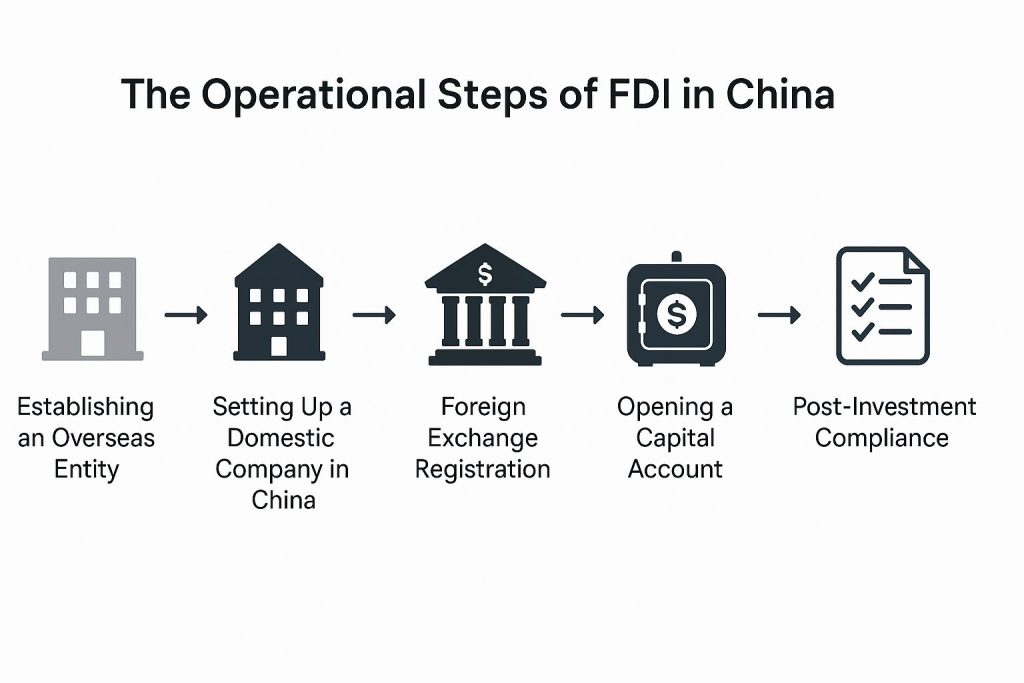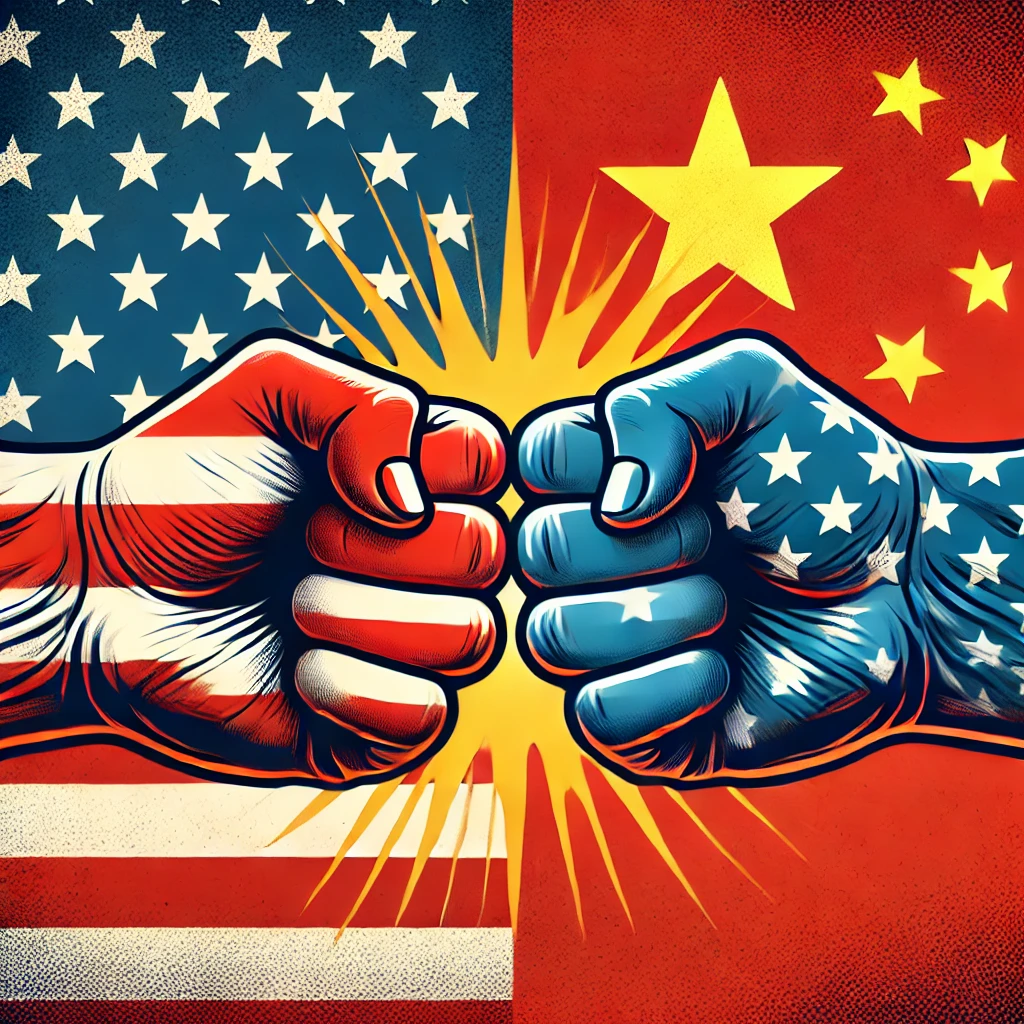Contents
Introduction:
Against the backdrop of a constantly evolving global economic landscape, China—now the world’s second-largest economy—continues to capture the attention of international investors. Foreign Direct Investment (FDI), as a vital bridge between global capital and the Chinese market, plays an increasingly indispensable role. This paper offers an in-depth analysis of the development path and strategic trends of FDI in China, covering its fundamental procedures, the comparison with Outbound Direct Investment (ODI), key regulatory checkpoints, operational steps, processing timeline, and recent policy shifts.
Understanding the Difference: FDI vs. ODI
Foreign Direct Investment (FDI) refers to overseas investors setting up enterprises or conducting direct investment activities within China. By contrast, Outbound Direct Investment (ODI) refers to Chinese enterprises investing abroad.
In terms of regulatory burden, FDI in China is notably more straightforward. Most projects only require foreign exchange registration with a qualified domestic bank. There is no need for pre-approval by central authorities — a stark contrast to ODI, which often involves multiple levels of government scrutiny.
This streamlined approach to FDI highlights a clear strategic intent: China actively welcomes foreign capital and has designed an infrastructure to attract it efficiently and effectively. It reflects a policy stance focused on openness, partnership, and selective globalization.
FDI in China: The Importance of Identifying True Foreign
One of the most critical yet underappreciated shifts in China’s FDI regime is this: FDI does not require government approval, but it does require verification of foreign ownership.
This verification takes place through a mechanism known as equity penetration — a process by which banks, regulators, and local authorities trace the actual controlling party of the investment. In essence:
-
If the ultimate beneficial owner (UBO) is revealed to be a Chinese national, the FDI process will be suspended.
-
If the investment is routed through Hong Kong, Singapore, or offshore structures, the full shareholder chain must still prove that the final controller is a foreign individual or legal entity.
This system reflects China’s goal of differentiating genuine foreign capital from disguised domestic capital — a move to prevent regulatory arbitrage and ensure that capital inflows serve the broader national agenda, not short-term profit seeking.
The Six-Step Process of FDI in China: Simplicity with Structural Depth
A typical FDI transaction today is executed in Six key steps:
-
Establishing an Overseas Company: The foreign investor sets up an offshore entity to act as the investing party.
-
Setting Up a Domestic Company in China: The offshore company serves as the shareholder to incorporate a domestic enterprise in Mainland China.
-
Foreign Exchange Registration: The domestic company registers the FDI with a designated Chinese bank and obtains the “FDI Business Registration Certificate.”
-
Opening a Capital Account: A dedicated capital account is opened with the bank to receive inbound foreign currency from the overseas investor.
-
Inbound Capital and Usage: After the capital is remitted into the account, it can be converted into RMB and used for lawful business activities within China.
-
Post-Investment Compliance: This includes filing annual reports, handling profit remittances, and equity changes, and maintaining ongoing regulatory compliance.
With complete documentation, the entire process can be completed in 3 to 4 weeks, and in some bank jurisdictions, foreign exchange registration can be done in as few as 6 business days.
No government approval. No Ministry of Commerce review. Just banking-level compliance and UBO verification.
But as simple as this may sound, the compliance behind it is structurally rigorous and reflects China’s evolving regulatory sophistication.
Industrial Shifts in FDI in China: From Manufacturing to Innovation-Driven Sectors
FDI in China has historically followed a predictable path: it began in low-cost manufacturing, evolved into value-added production, and is now rapidly entering innovation-driven service sectors.
The current industry trends can be summarized as follows:
-
Traditional manufacturing remains a stronghold, particularly for high-end equipment, precision components, and automotive supply chains;
-
High-tech industries — semiconductors, biopharma, new energy, advanced materials — are now FDI hotspots;
-
Modern services — in finance, IT, logistics, R&D, and consulting — are driving a new wave of inbound capital;
-
Digital economy sectors such as SaaS platforms, cloud services, and cross-border e-commerce are drawing foreign investors seeking long-term market presence.
According to China’s Ministry of Commerce:
“In 2024, more than 42,000 new foreign-invested enterprises were established nationwide. High-tech industries accounted for 36.8% of total FDI, and the service sector exceeded 62%, signaling an ongoing structural upgrade in China’s foreign investment profile.”
China is no longer just a factory. It is fast becoming a testbed for innovation, and FDI is being used as a lever to attract not just capital — but expertise, IP, and global know-how.
The Core Due Diligence Behind Every FDI Transaction
Despite the simplified procedures, FDI in China still requires clear documentation and verification across 3 key checkpoints:
-
Legitimacy of Capital Origin: All foreign funds must have clear, legal sources that comply with China’s foreign exchange rules.
-
Compliance of the Investment Project: The business scope and activities must align with China’s industrial policies and sectoral regulations.
-
Equity Penetration and Control Structure: Authorities will conduct equity chain analysis to ensure that the true controlling party is a non-Chinese entity. If the ultimate beneficial owner is found to be a Chinese citizen, the FDI transaction cannot proceed.
These steps ensure that FDI into China is not only legal and traceable but also aligned with national economic interests and regulatory frameworks.
How Free Trade Zones Are Shaping the Future of FDI in China
China’s Free Trade Zones (FTZs), starting with Shanghai in 2013, have played a critical role in experimenting with new FDI models that eventually shape national policy.
Several innovations have now become institutionalized:
-
Negative list management – All sectors not explicitly prohibited are open to foreign investment under filing-based procedures;
-
Capital item liberalization – FDI capital can be used for intra-China equity investment, R&D expenses, and inter-provincial transfers;
-
Tax and finance innovations – Cross-border shared service centers and simplified forex procedures have reduced operational friction;
-
Sensitive sector pilot projects – Full foreign ownership in healthcare, education, and telecom is allowed in FTZs like Hainan.
Together, these policy tools send a strong signal: China is not just welcoming foreign capital; it is actively optimizing its environment for long-term, high-quality FDI.
Changing Capital Structures: New Geographies, New Strategies
FDI inflows into China are also evolving in terms of capital origin, structure, and intent:
-
Source countries are diversifying. While the U.S., Germany, Japan, and Singapore remain core investors, sovereign funds from the Middle East and Latin American industrial players are increasingly active, especially in logistics and renewable energy;
-
Holding structures are more sophisticated. Multi-layer holdings, BVI vehicles, and SPV structures are now standard, designed for tax efficiency, legal clarity, and governance separation;
-
Investment strategies are broader. Beyond greenfield factories, FDI is now entering China via equity participation, limited partnerships, and long-term asset control.
Foreign Direct Investment is no longer just a financial activity — it is a strategic commitment. Investors are building platforms, not just projects.
Amidst a New Cold War — The Window Is Narrow, But Open
In April 2025, the U.S. Treasury imposed a new wave of sanctions on select Chinese high-tech firms, citing national security risks. In parallel, China’s National Development and Reform Commission released a revised Catalogue of Encouraged Industries for Foreign Investment — expanding access in clean energy, AI, and smart manufacturing. The juxtaposition is revealing.
According to data from the State Administration of Foreign Exchange, even though Foreign Direct Investment in China dropped to one of its lowest levels in 2024, Chinese enterprises have accelerated their investments abroad.
FDI is no longer a purely economic action. It is a political signal, a strategic alignment, and increasingly, a long-term wager on the future of globalization. In this new environment:
-
For China, FDI is not just about attracting money. It’s about attracting capital that is willing to integrate, comply, and co-evolve with the Chinese economy;
-
For investors, entering China is no longer just about market opportunity. It’s about understanding legal rhythms, regulatory culture, and geopolitical risks.
From the world’s factory to the world’s sandbox, China is redefining what foreign investment means. From opportunistic capital to structural capital, the world is rethinking how to invest in China.
Conclusion:
There is no easy path forward. But the door is not closed.
Yes — the window is narrower.
Yes — the cost of entry is higher.
But for those with patience, insight, and true commitment, the next decade may offer the most meaningful decade of FDI in China yet.




